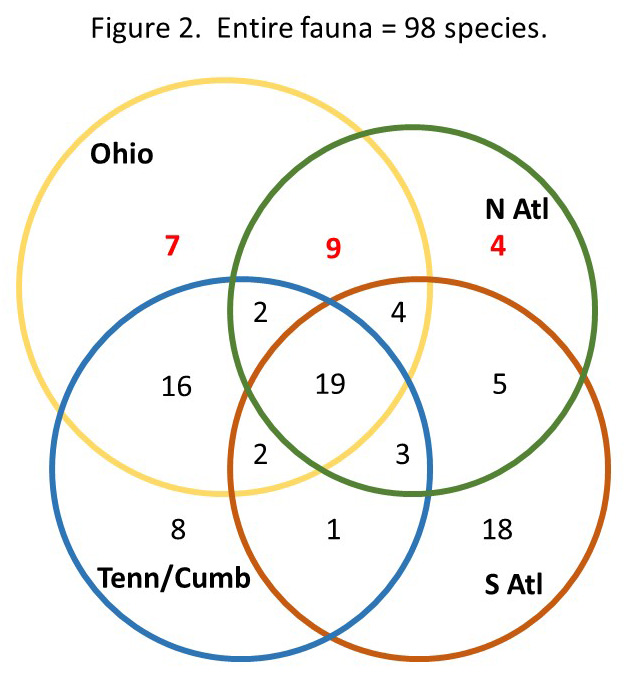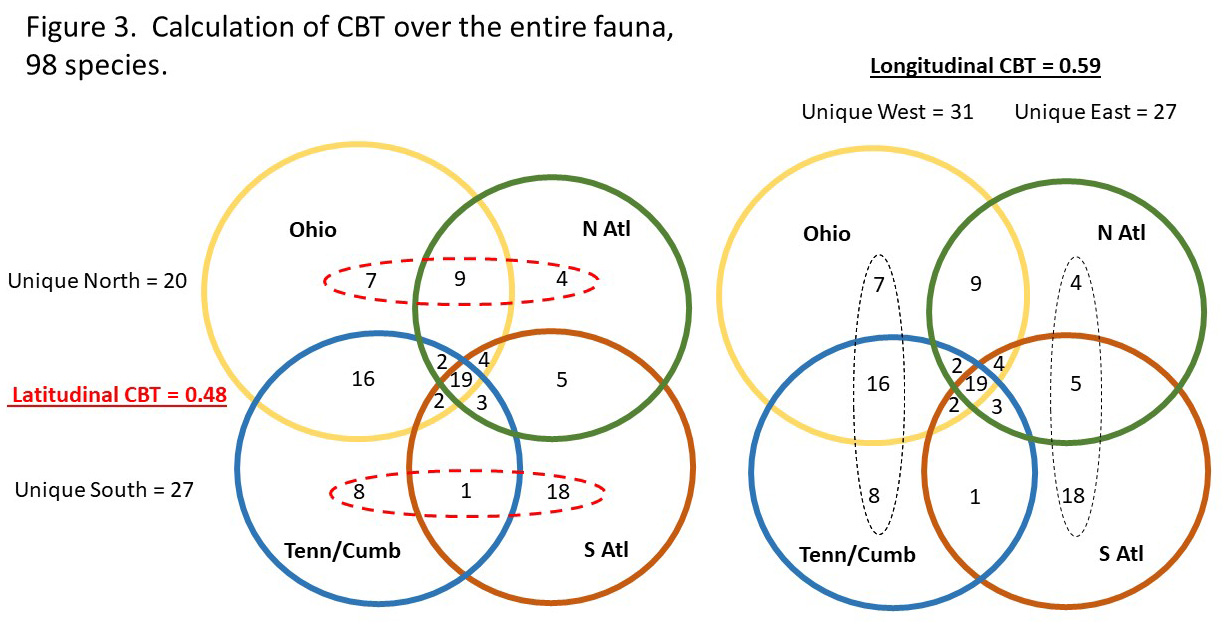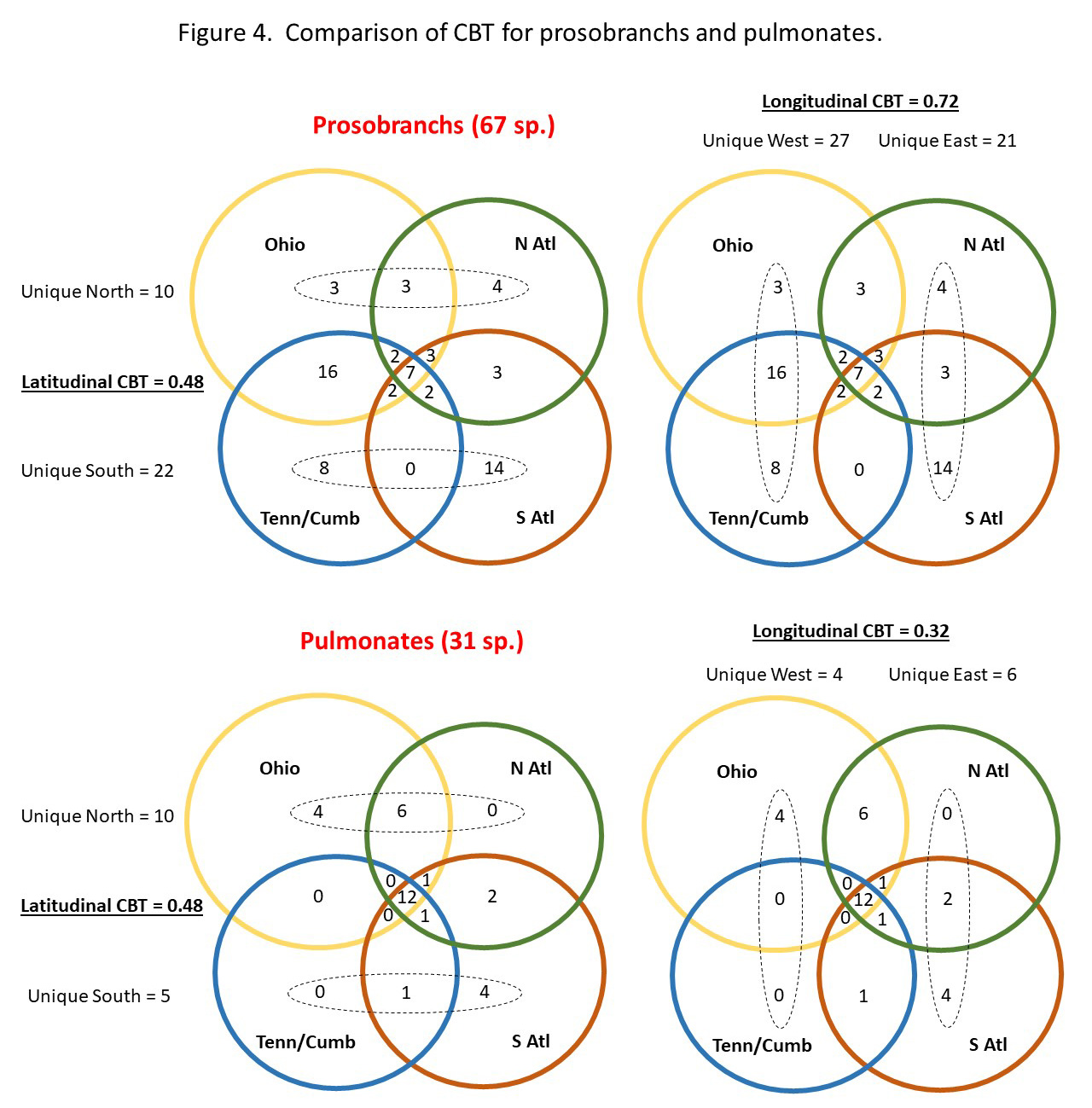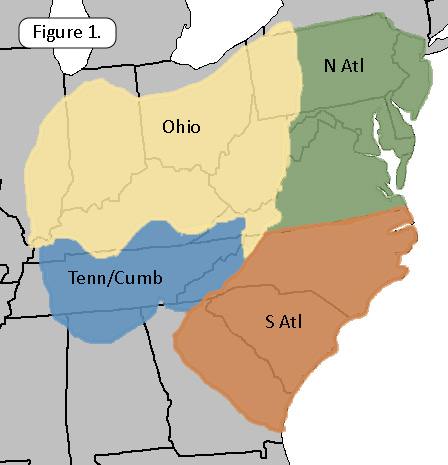
Any rigorous study of biogeography must begin with a specification of scale. The large and important literature that accumulated through the 20th century aimed at understanding the distribution of freshwater gastropods at small and local scales has been reviewed by Dillon (2000: 326 - 366). And the variety of studies specifically directed toward the freshwater gastropod faunas of individual states and drainage systems in Eastern North America are here reviewed on the home pages of the several regions currently covered on this website: Georgia Atlantic (FWGGA), South Carolina (FWGSC), North Carolina Atlantic (FWGNC), Virginia Atlantic (FWGVA), the Mid-Atlantic drainages (FWGMA), the Ohio drainages (FWGO), and the drainages of the Tennessee/Cumberland (FWGTN).
Here we examine the factors influencing the distribution of North American freshwater gastropod species at a continental scale. Our study area spans 11 degrees of latitude from South Georgia to the New York line, a linear distance of approximately 1,000 km. And for any biota sampled up any such range, surely the first variable that must come to mind would be latitude, as a more-easily measured correlate of climate: temperature, light, growing season, and interactions with other floral or faunal elements covarying with climate.
Our study region is also approximately 1,000 km wide, spanning 15 degrees of longitude. Climate does not vary as greatly by longitude as it does by latitude in Eastern North America; Ohio enjoys approximately the same climate as Pennsylvania, and Tennessee the same as North Carolina. But our study area is bisected by the Appalachian divide, an ancient series of mountain ranges pushed up by multiple orogenic events in the Paleozoic era. For hundreds of millions of years, half of the rivers in our study area have flown east to the Atlantic, and half have flown west to the continental interior. It seems quite likely to us that such an evolutionary feature might have left an historic fingerprint on the biogeography of the North American freshwater gastropod fauna.
The purpose of this study is to examine the relative importance of the latitudinal climate variable and the longitudinal historic variable in determining gastropod diversity in the rivers, lakes and streams of North America east of the Mississippi River. To the extent that climate may affect natural selection, and a mountainous barrier to dispersal may affect gene flow, our results might be interpreted to offer some estimate of the relative importance of natural selection and gene flow restriction in the evolution of the freshwater Gastropoda.
> Version History
FWGNA
biogeography v1.0
was published on this website in 2019, with the expansion of the FWGNA
project into the drainages of The Ohio. Our database of
19,643
records documented the distributions of 102 species and 9 additional
subspecies. At that date it became possible to compare the
faunas
of North Atlantic drainages and East Tennessee with the fauna of The
Ohio using a rectangular matrix approach. Our findings,
published
in an expanded discussion on the FWGO site, were:
- East/West regionalism. A gradual turnover of pulmonates proceeding east, slightly net negative, and an abrupt discontinuity of prosobranchs, strikingly net negative.
- North/South regionalism. A gradual turnover in prosobranchs heading south, net neutral, and an abrupt discontinuity of pulmonates, strikingly net negative.
As
of 2019, however, the FWGNA project covered only East Tennessee –
neglecting Middle Tennessee, North Alabama, and the entire Cumberland
River drainage. Although that initial effort at a large-scale
biogeography of the North American freshwater gastropod fauna has been
rendered obsolete by the present analysis, it remains available as
FWGNA Circular #4 [pdf].
> Version 2.0
The 107 species of freshwater gastropods inhabiting our 17-state study area are listed systematically in Table Bi1 [pdf] [.xls], combining 21 additional subspecies under their parents. Among these are eight stygobiontic hydrobioids, obligately adapted to caves and subterranean interstitial spaces. Also included on the list is Pomatiopsis lapidaria, ecologically a land snail. Inadequate sampling dictates that these 9 species be excluded from further analysis.
 Then
of the 98 species remaining, 59 occur in the drainages of The Ohio, 46
in Atlantic drainages from Virginia north to the New York line (N Atl),
52 occur in the Atlantic drainages of the Carolinas and Georgia (S
Atl), and 51 species occur in the drainages of the Tennessee /
Cumberland. Figure 2 shows how these 98 species are shared
among
the four biogeographic regions, each region depicted as a circle of
area relative to its total fauna.
Then
of the 98 species remaining, 59 occur in the drainages of The Ohio, 46
in Atlantic drainages from Virginia north to the New York line (N Atl),
52 occur in the Atlantic drainages of the Carolinas and Georgia (S
Atl), and 51 species occur in the drainages of the Tennessee /
Cumberland. Figure 2 shows how these 98 species are shared
among
the four biogeographic regions, each region depicted as a circle of
area relative to its total fauna.
A total of 19 species are
shared across all four regions: 7 (10%) of the prosobranch fauna and 12
(39%) of the pulmonate fauna. A total of 37 species are
endemic
to just one of the four regions: 29 (43%) of the prosobranchs and 8
(26%) of the pulmonates. The drainages of The Ohio, for
example,
host 7 species not found in any other region, and the North Atlantic
drainages host 4 species not found elsewhere. In addition,
the
Ohio and the North Atlantic share 9 species not found in either the
Tenn/Cumb or the South Atlantic. Figure 2 shows those three
integers (7, 4, and 9) marked in red font.
> Coefficients of Biotic Turnover
Our survey has identified a sum total of 7+4+9 = 20 freshwater gastropod species inhabiting northern latitudes that do not inhabit southern latitudes. The left half of Figure 3 shows that subset of 20 encircled with a red dashed oval. And by extension, the left half of Figure Bi3 also shows that 8+1+18 = 27 species are unique to southern latitudes. Those integers are also encircled with a red dashed oval.
 |
Here we suggest a simple Jaccard statistic to measure biogeographic structure in a fauna surveyed over large scale. We define the coefficient of biotic turnover (CBT) as CBT = (X+Y)/Z, where X and Y are the numbers of species unique to a pair of regions under study, and Z is the total number of species found in both regions. Thus, combining the Ohio and N Atl into a North region and the Tenn/Cumb and S Atl into a South Region, CBT = (20+27)/98 = 0.48 for latitude effects, presumably a response of the North American freshwater gastropod fauna to variation in climate.
And just as we lumped our four regions into categories of North and South, our four regions can also be lumped into categories of East and West, and a CBT calculated for longitude in a fashion analogous to the above for latitude. The right half of Figure 3 shows that CBT = 0.59 across the eastern continental divide, presumably a measure of evolutionary isolation.
> Freshwater Gastropod Evolution
The 98-species freshwater gastropod fauna of eastern North America includes 67 prosobranchs and 31 pulmonates. These two subclasses of snails are very different biologically. The prosobranchs are gill-bearing and (typically) slower-growing, longer-lived, iteroparous and dioecious. The pulmonates have lost the gill from inside their mantle, which now functions as a lung, and are hermaphroditic. They are typically semelparous, more rapidly-growing and shorter-lived than the prosobranchs, and usually able to self-fertilize as well as outcross.
In Figure 4 we have repeated our CBT analysis for the two faunal subsets separately, the 67 prosobranchs and the 31 pulmonates. The left half of Figure 4 shows no evidence of any interaction between latitude and the biology of the freshwater gastropod fauna responding to it. For prosobranchs, the latitudinal CBT = 0.48, and for pulmonates, the latitudinal CBT = 0.48, identical. In other words, the pulmonate fauna of North America and the prosobranch fauna of North America respond identically to the climatic change up a 1,000 km gradient of latitude, both turning over about 48% of their species.
 |
Our results are quite different when we compare the prosobranch fauna and the pulmonate fauna in their response to longitude. The right half of Figure 4 shows a strikingly high faunal turnover for prosobranchs, CBT = 0.72, and a strikingly low faunal turnover for pulmonates, CBT = 0.32. The pulmonate faunal turnover is much lower for 1,000 km of longitude than for 1,000 km of latitude. But the longitudinal rate of prosobranch faunal turnover is much higher than its latitudinal turnover, amounting to more than double the pulmonate rate.
> Discussion
Dillon (1984) estimated morphological and genetic divergence (calculated from 7 polymorphic allozyme-encoding loci) across 25 populations of Goniobasis (now Pleurocera) proxima inhabiting a mountainous slice of the Virginia, North Carolina, and Tennessee border. He compared the divergence matrices that resulted to matrices of physical, chemical, and biological variables (as a measure of selection) and matrices of geographic distance (as a measure of gene flow restriction). He found that population divergence (by all measures) was highly correlated to geographic distance (by all measures), suggesting that in case of the prosobranch P. proxima, evolution is more a function of gene flow restriction than selection.
The second-most interesting discovery we document here is the identical 48% rate of latitudinal turnover demonstrated by the pulmonate and prosobranch faunas of eastern North America. The prosobranchs are more diverse in the lower latitudes, with 22 species unique to the south and 11 unique to the north. The pulmonates demonstrate the opposite effect: 5 unique to the south and 10 unique to the north. Yet despite their apparently opposite responses, both faunas demonstrate identical 48% turnover rates up a 1,000 km cline of climatic variance.
We suggest that, over time scales on the order of 10^8 years and distances on the order of 10^3 kilometers, latitudinal faunal turnover is a function of adaptation. In the freshwater pulmonates of eastern North America, for example, 5 species have specialized on warmer climates and 10 species have specialized on cooler climates, and 16 have remained more general. A value of CBT = 48% is a very indirect measure of the importance of natural selection in the evolution of a fauna.
The first-most interesting discovery we have documented in the present analysis is the striking difference between the 32% rate of longitudinal turnover demonstrated by the 31 species of pulmonate gastropods inhabiting the waters across eastern North America and 72% rate demonstrated by the 67 prosobranch species sampled across those same waters. Neither group shows any trend – western and eastern faunas roughly equal in their diversity. Since both groups are responding to the same climate, the difference must be due to some biological difference in the snails themselves.
We suggest that, over time scales on the order of 10^8 years and distances on the order of 10^3 kilometers, longitudinal faunal turnover is a function of dispersal capability. Lung-breathing pulmonate freshwater gastropods, more lightly-shelled, more rapidly-reproducing, and hermaphroditic, are in general better dispersers than prosobranch freshwater gastropods. And hence we suggest that values of CBT are very indirect measures of the importance of gene flow restriction in the evolution of a fauna.
Then since 0.32 < 0.48, natural selection has been more important in the evolution of freshwater pulmonates than gene flow restriction. And since 0.72 > 0.48, gene flow restriction has been more important in the evolution of freshwater prosobranchs than natural selection.
> Future Prospects
In April of 2024 the FWGNA Project expanded to include the prairie states of Kansas, Nebraska, South Dakota and North Dakota [FWGGP]. A separate stand-alone biogeographic analysis for the Great Plains freshwater gastropod fauna was posted at that time, suggesting that observed reductions in species richness might be a function of historical, rather than environmental factors. We plan to integrate our results from West of the Mississippi River with the 17-state Eastern Synthesis presented above when results become available for Missouri and Arkansas.
>
References
Dillon, R.T., Jr. (1984)
Geographic distance, environmental difference, and divergence between
isolated populations. Systematic Zoology 33:69-82. [PDF]
Dillon, R.T. (2000)
The Ecology of Freshwater Molluscs. Cambridge University
Press.
509 + xii pages, 27 tables, 99 figures. ISBN: 0 521 35210 X. [html]
Dillon, R.T., Jr., M.J.
Ashton, W.K. Reeves, T.P. Smith, T.W. Stewart, & B.T. Watson
(2019)
Atlantic drainages, Georgia through Pennsylvania. Freshwater
Gastropods of North America, Volume 1. FWGNA Press.
199 pp. [html]

